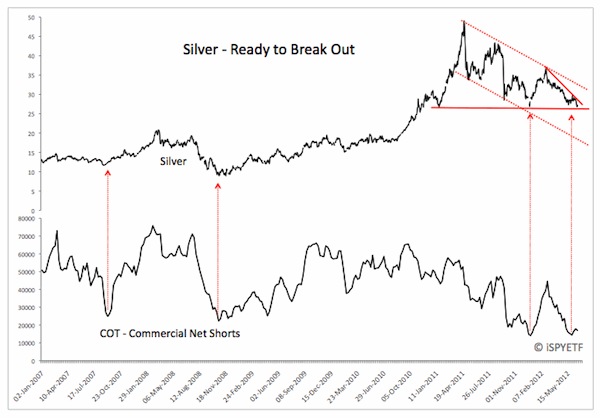January 2011. That’s when silver prices started carving out a massive descending triangle.
A descending triangle has a horizontal lower boundary line (called demand line) and a down-sloping upper boundary line (called supply line).
The implication of a descending triangle is generally bearish. Several ancillary components will either increase or decrease confidence in the reliability of the pattern.
Decreasing volume before the breakout and increasing volume accompanying the breakout increase confidence. Trading volume for silver futures has been on the decline, an indication that the pattern will work out.
However, good reliable breakouts from a descending triangle usually occur at about the same stage of pattern completion as they do in symmetrical triangles. The earlier the breakout the less apt it is to be a false move.
In the case of silver (chart below), prices are squeezing right out to the apex without any breakout yet. This increases the odds of the triangle breakout failure.

What makes silver’s triangle more intriguing is the smaller triangle within the larger triangle. And wait … there is more: If you chart the iShares Silver Trust (SLV) you will note that prices already fell and climbed back above the lower support line.
Supplementing Technicals
I like looking at technicals, but have found that it takes more than a one-dimensional analysis to identify high probability trading opportunities.
The bottom of the chart shows the net short positions of commercial silver futures traders. Commercial traders include silver producers who use futures to sell future production. Because they are active in the business they are considered the “smart money.”
The latest Commitment of Traders (COT) report shows that the smart money is less short now than at previous silver bottoms. From a sentiment point of view, that’s bullish for silver.
Summary
Silver’s performance often sets the tone for U.S. stocks and major indexes like the S&P (SPY), Dow (DJI) and Nasdaq (QQQ), so what silver does here might provide valuable clues for investors of all sorts.
The silver market thinks the lower trend line at 26 is important, otherwise it wouldn’t have touched it several times. If the market thinks so, we should too.
Incidentally, gold prices and the SPDR Gold Shares (GLD) are also sitting atop important support. After an extended period of sideways trading, it seems like we’re getting ready to see some fireworks.
The Profit Radar Report will try to identify how to best take advantage of big moves.
|